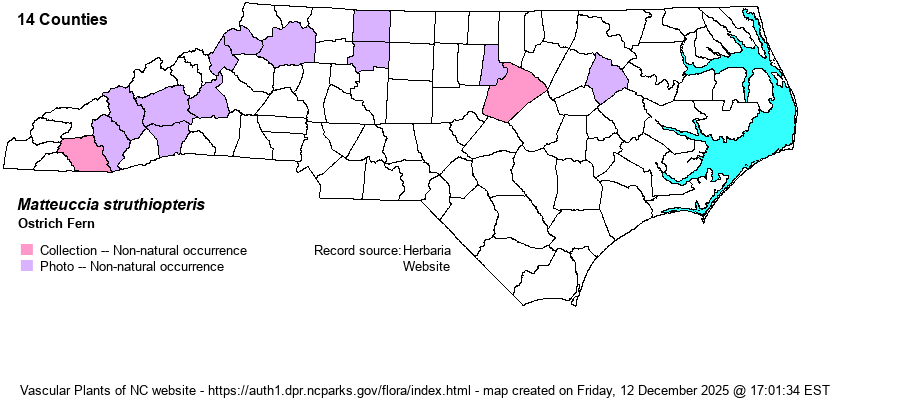| Author | (L.) Todaro | |
| Distribution | This more northerly species has been collected historically and photographed recently at a number of sites in the Piedmont and Mountains, and in at least one Coastal Plain county. Because Weakley's NC Floras (through 2024) had not included this species in the state, this website also had not included it either. However, it is reported as escaping away from cultivation by Bryan England in Wake County (2024), and thus it seems time to add this fern to the state list. It is easily overlooked as Osmundastrum cinnamomeum by most biologists; indeed a 1968 specimen from Clevelend County is actually Cinnamon Fern. As of October 2024, there is only a single specimen of Ostrich Fern from NC: Highlands Biological Station in 2015, where likely planted.
Ranges from northern VA west to MO and NE, and then northward. Records in NC are clearly non-native occurrences. | |
| Abundance | Very rare but increasing. There are a few dozen Research Grade photos on iNaturalist, and one specimen in SERNEC, but many or most might be from gardens and thus not-usable for mapping purposes. The State Rank is SE (Exotic). | |
| Habitat | "Alluvial forests and calcareous wetlands; sometimes grown as a woodland garden (shade) ornamental." (Weakley 2024a). | |
| Phenology | | |
| Identification | This is a very tall species, with sterile fronds generally reaching from 2-6 feet tall in the wild. The fronds grow from a clump and gracefully arch outward. The much shorter fertile fronds are erect and grow in the center of the clump of the sterile fronds. | |
| Taxonomic Comments | The native North American taxon is Matteuccia struthiopteris var. pensylvanica, and the Eurasian native is Matteuccia struthiopteris var. struthiopteris. From online discussion by Bryan England and others, It is clear that both varieties are now in NC.
| |
| Other Common Name(s) | | |
| State Rank | SE | |
| Global Rank | G5 | |
| State Status | | |
| US Status | | |
| USACE-agcp | | |
| USACE-emp | | |

